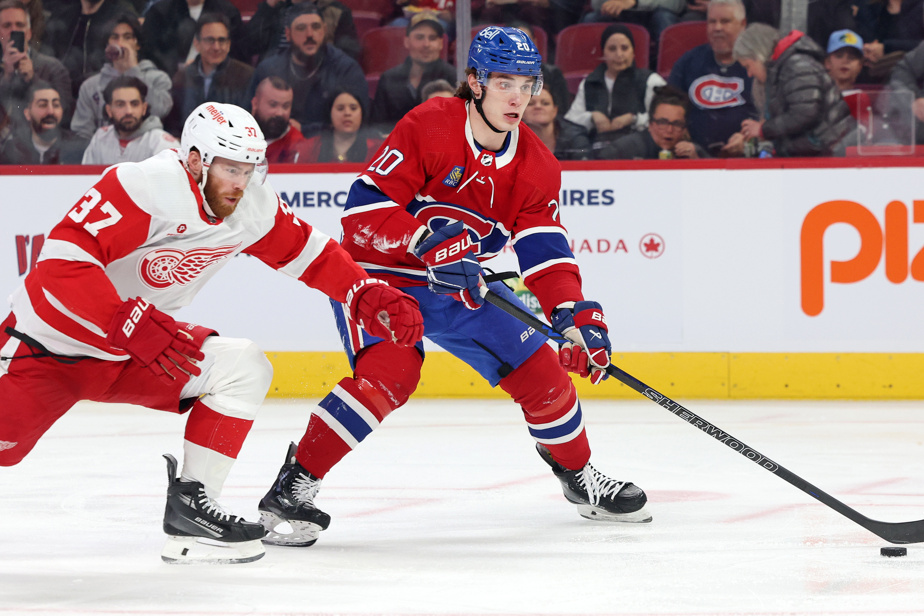The Juraj Slafkovsky deal didn’t drag on. The forward was eligible for a 2025 contract extension starting Monday, and the deal was done on Day 1.
An eight-year deal, worth $60.8 million, for an annual average of $7.6 million.
The case was obviously not resolved magically on the 1ster July. The talks lasted “about a month,” estimated Kent Hughes, at a press briefing in Brossard on Monday.
He’s someone we drafted number 1, he’s very important for the future of the Montreal Canadiens. Juraj, for his part, loves Montreal, the city, he loves playing here. The goal was always to see if we were able to find a long-term contract, even if it was eight or seven years, even six years.
Kent Hughes, general manager of the Canadiens
The two camps finally agreed on eight years, the maximum duration allowed, which binds Slafkovsky to the Tricolore until 2033.
2033 is a long way off. For reference, that summer, Nick Suzuki will be a 34-year-old veteran, Martin St. Louis will be 58, and the New York Mets will have only two years left on Bobby Bonilla’s payments.

PHOTO DOMINICK GRAVEL, LA PRESSE ARCHIVES
Juraj Slafkovsky and Nick Suzuki
Slafkovsky, meanwhile, will be 29, and the team is obviously hoping that his meteoric rise from last season will continue so that he can become a bargain. Starting in mid-December, he has truly transformed and cemented his place alongside Nick Suzuki and Cole Caufield. In 53 games starting Dec. 15, he has scored 43 points, including 18 goals, and averaged 19 minutes per game.
Respect for the structure
Beyond the length, however, it is the annual salary of $7.6 million that is interesting, because it demonstrates Hughes’ willingness to respect a salary structure of which Suzuki is the reference point.
Hughes declined to elaborate on the details of the negotiations; Slafkovsky will speak to the media on Tuesday and it remains to be seen whether he will reveal more. But the CEO has clearly identified his parameters.
“We believe that every team has an internal structure,” he said. “Nick is our captain, our leader. I think people in the organization respect that, the players too.”
This is the second time Hughes has had to flirt with this psychological limit. Let’s first clarify that Suzuki’s salary itself is a legacy of the previous administration: his contract was the last one that Marc Bergevin signed as GM of the Canadiens, in October 2021.
Caufield was eligible for a contract extension in the summer of 2022, but he decided to play out the 2022-23 campaign without securing his long-term future. He responded with 26 goals in 46 games (a shoulder injury ended his season), and by June, the diminutive winger was on the hook for $62.8 million over eight years.
Hughes also explained that Slafkovsky could have also started the next season without an extension in his pocket and thus bet on himself. “We told him that we had no problem paying him more,” Hughes acknowledged. “But we were so close, we decided to sign the contract.”
In short, Hughes wanted to respect the structure, but Slafkovsky could have crossed the psychological line by having a great season. Two in the bush, he preferred one in the hand.
The Leafs Case
Sooner or later, this structure will be put to the test. Kent Hughes, however, made it clear that now is not the time to go on a spending spree.
For reference, only one contract signed Monday, on Day 1 of the free agent market, is worth more than Suzuki’s. That’s Steven Stamkos, who got $8 million per season in Nashville.
But until then, the CH avoids the inflationary spiral in which the Toronto Maple Leafs have been caught since the hiring of John Tavares as a free agent in 2018. As a reminder:
- John Tavares, 1er July 2018: $11 million per year contract
- Auston Matthews, February 5, 2019: $11.634 million contract
- Mitch Marner, September 13, 2019: $10.903 million contract
- Auston Matthews, August 23, 2023: $13.25 million contract
- William Nylander, January 8, 2024: $11.5 million contract
These four forwards will occupy 53% of the Leafs’ payroll next season, which has consequences for the rest of the team.
Matthews and Marner, though, are also elite-caliber players, which creates different parameters. But Tavares’ arrival in the mix has obviously set a very high ceiling for what comes next.
Hughes’ caution in his pursuit of big names may infuriate the impatient, but when it comes to negotiating with youngsters, that restraint serves him well. It should also be the case when he sits down with Kaiden Guhle, the next big thing on the table, a player who can also sign a one-year contract extension early this summer.
“It may not have started at the same pace as Slaf,” Hughes acknowledged, “but if we’re able to find a contract, we’ll do it this summer.”
